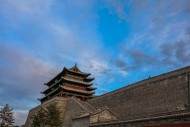

Introducing Datong Shanhua Temple
Shanhua Temple is a Buddhist temple located in Datong. Shanhua Temple was first founded during the early 8th century of the Tang dynasty. The earliest surviving building of Shanhua Temple dates from the 11th century. The temple was heavily repaired over the years, and today three original halls and two recently rebuilt pavilions survive. The largest, and earliest hall, dating from the 11th-century Liao dynasty, is the Mahavira Hall and is one of the largest of its kind in China. Also historically significant are the Main Gate and Sansheng Hall, both dating from 12th century during the Jin dynasty.
Watch this video showcasing Datong Shanhua Temple
Kind Notice: You can not watch this video if you are in China (YouTube is blocked in China).
Datong Shanhua Temple Fast Facts
• Chinese Name: Shan Hua Si 善化寺
• Best Time to Visit: April, May, Sept & Oct
• Recommended Visiting Hours: About 1 hour
• Things to Do: Buddhist culture, tradtional Chinese architecture
• Opening Hours: 08:00 to 18:00 from May to Oct; 08:30 to 17:30 from Oct to Apr
• Entrance Fee: CNY 50; free for children under 1.2m (3.9ft)
• Address: No. 6, Nansi Street, Pingcheng District, Datong
Why Visit Datong Shanhua Temple
The Mahavira Hall at Shanhua Temple, which hails from the 11th-century Liao Dynasty, is recognized as one of the most expansive of its type in China. Equally noteworthy are the Temple Gate, also known as the Gate of Heavenly Kings, and the Hall of the Three Worthies. Both of these structures were established in the 12th century during the era of the Jin dynasty.
What to Expect at Datong Shanhua Temple
The Shanhua Temple consists of three main halls (The Mahavira Hall, the Hall of the Three Worthies and the Temple Gate) arranged on a north-south axis and two pavilions located to the east and west of the Hall of the Three Worthies. To the west of the Hall of the Three Worthies lies the Samantabhadra Pavilion. Avalokitesvara Pavilion and Ksitigarbha Pavilion are situated on the two sides of the Mahavira Hall
Five-Dragon Screen Wall.
The Five-Dragon Screen Wall is made of colored glaze. This screen wall was first at Xingguo Temple in Datong and was moved to the current location in 1980. A screen wall is placed at the front of a temple to stop ghosts or evil spirits from entering. The idea is that evil spirits cannot turn corners , and so the wall screens the main entrance. Screen wall decorated by dragons is an aesthetic feature and projects the high-status of the temple to visitors.
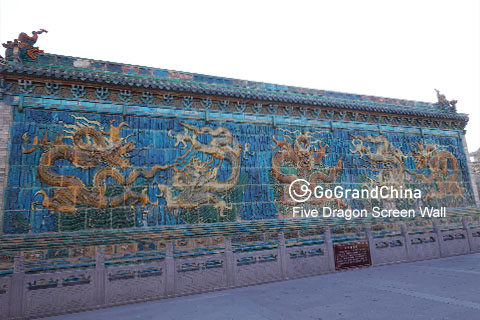
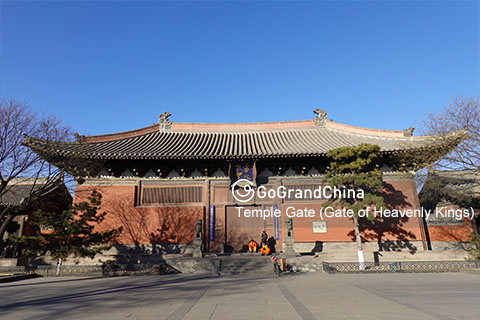
Temple Gate (Hall of Heavenly Kings)
The temple gate of Shanhua Temple was built during the Jin dynasty in the 12th century. It is five bays wide, and two bays deep with a single eave and hipped roof. Hipped foof is of the highest level in traditional Chinese architecture. Only the royal family and Confucius had the privilege to use such style of roof since the Ming Dynasty. This gate contains statues of the four heavenly kings, with two on the east side, and two on the west side. The temple gate of Shanhua Temple is the biggest extant temple gate of the Jin Dynasty now in China.
The Hall of the Three Sages
The Hall of the Three Sages were rebuilt by the Jin (1128-1143). It is 5 bays wide and 4 bays deep, with a single eave and a hipped roof. It houses statues of the three sages of the Avatamsaka Sutra - a central one of Vairocana (the universal aspect of Shakyamuni) and two accompanying statues of Manjusri and Samantabhadra. The hall has very few central pillars for its support and depends on complex rafters and brackets for its support.
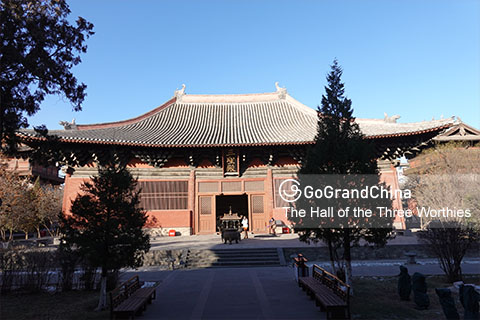
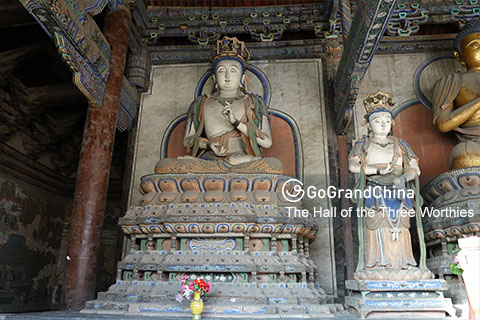
Samantabhadra Pavilion & Manjushri Pavilion
Along the way to Mahavira Hall, one can see two pavilions – the Pavilion of Bodhisattva Samantabhadra on the west and the Pavilion of Bodhisattva Manjushri on the east. The Samantabhadra Pavilion is a 2-storey square structure with wooden stairs inside leading to the top for outside view, was first built in year 1154 in Jin Dynasty, following its original style of Liao Dynasty. It enshrines an image of Bodhisattva Samantabhadra. The Pavilion of Bodhisattva Manjushri enshrines an image of Bodhisattva Manjushri. It was destroyed in the early 20th century and rebuilt by local government in 2008.
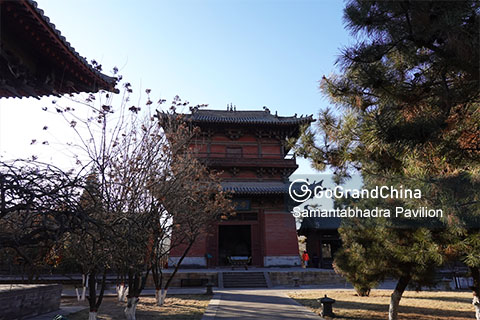
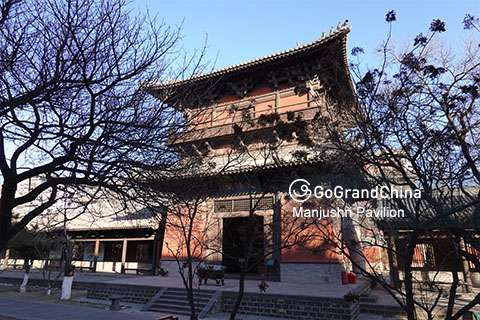
The Mahavira Hall
The Mahavira Hall of Shanhua Temple dates from the 11th century during the Liao Dynasty (907-1125), having apparently survived the end of that dynasty. It is 7 bays wide by 5 bays deep, with with a single eave and hipped roof, and has three doors at the front of the hall. The hall is built on an elevated three meter high platform and contains a spread of original Buddhist statues. The main statues in this hall are the Five Directional Buddhas, the central statue representing Sakyamuni. The statues are similar, and represent the Buddha displaying different mudras (symbolic hand gestures). Above the Sakyamuni statue, is a caisson, an octagonal wooden ceiling that is painted and decorated. Along with other statues of disciples and attendants grouped with the large statues, there are also 24 deva statues located next to the east and west walls. There are 190 square meters of murals in the hall, dated from 1708 to 1716.
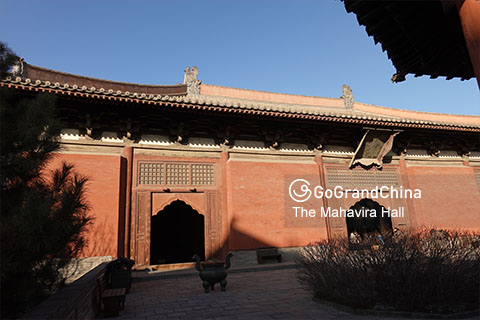
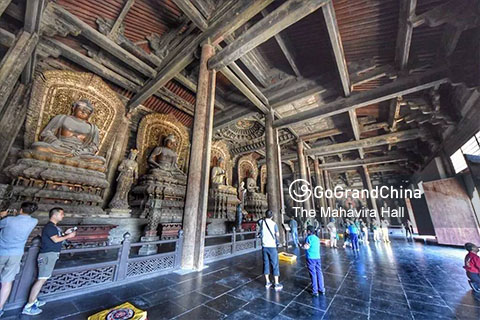
How to Get to Datong Shanhua Temple
• Shanhua Temple is located inside the newly built Datong City Wall.
• By Bus: take bus 65 to Yongtaiximen Station.
Tour Highlights
• Marvel at Yungang Grottoes, a classical masterpiece of the first peak of Chinese Buddhist art
• Visit Huayan Temple with the oldest building in Datong (1038), containing some remarkable Liao dynasty wooden sculptures
• Visit Shanhua Temple, the largest and best-preserved temple of the Liao Dynasty in existence in China
• Admire the Nine-Dragon Wall, the oldest, largest, most enchanting one among the three famous dragon walls in China
• Visit Datong City Wall, 7.2km in circumference rebuilt recently
About This Tour
• Departure: Daily departing from Datong
• Tour Duration: Approximately 8 hours.
• Guide Languages: Chinese & English.
• Pickup Time: Between 07:00 and 10:00, choose a departure time most suitable for you.
• Pickup & Drop-off Place: Your accommodation in Datong
• Advice on Meals: Lunch is not included in this tour. We recommend having a substantial breakfast and bringing snacks in case you get hungry while sightseeing. If you'd like to experience authentic local cuisine for lunch, feel free to inform your guide, who will be happy to assist.
Tour Itinerary at a Glance
• Pick up from your accommodation in Datong
• Drive to Yungang Grottoes (about 18km)
• Visit Yungang Grottoes
• Lunch on your own
• Visit Huayan Temple
• Visit Shanhua Temple
• Visit Nine-Dragon Wall,
• Walk Datong City Wall
• Transfer back to your accommodation in Datong
Tour Prices (US$ Per Person)
| 1 person | 2 people | 3 people | 4 people | 5 people | 6 people | 7 people | 8 people | 9 people | 10 + |
| $438 | $248 | $188 | $148 | $138 | $128 | $118 | $108 | $98 | $88 |
Price Remark
• Prices are not valid during National Day (Oct 1-7), Chinese New Year, and Labor Day (May 1-5).
Price Inclusions
• Professional English language speaking tour guide.
• Air-conditioned vehicle with an experienced driver.
• Admission tickets to sightseeing places.
• All government taxes.
Price Exclusions
• Hotel accommodation.
• Meals are excluded allowing you flexibility on menu.
• Your personal expenses.
• Travel insurance is not included. Please purchase before your trip to provide for any unforeseen circumstances.
• Gratuities to guide & driver. They are customary and would be of great encouragement and reward for quality service.
Additional Information
• Confirmation will be received at the time of booking.
• Operates in all weather conditions, please dress appropriately.
• The itinerary is subject to change due to traffic conditions or bad weather.
• The itinerary is flexible; changes can be made upon written request from travelers.
• IMPORTANT: It is required by the government regulations that travelers must provide their name, gender, nationality, passport number and date of birth to their tour operator upon booking a tour. Failure to do so could result in being denied access or admittance to sites and attractions during sightseeing. When you book this tour, please complete all required fields at checkout. Please bring your passport with you on the tour.
Cancellation Policy
• Cancellations made 24 hours prior to the scheduled departure time will receive a 100% refund.
• Cancellations made within 24 hours of the tour's start time or after the tour begins are non-refundable.
• Cancellation request will be confirmed within 2-5 business days, with refunds issued within 14 working days.
Tailor This Tour to Meet Your Needs
• If you want to customize this itinerary, contact us via WhatsApp (+86 139 1083 0737) or email (info@GrandChinaTravel.com). We'll create a tailor-made tour package just for you.